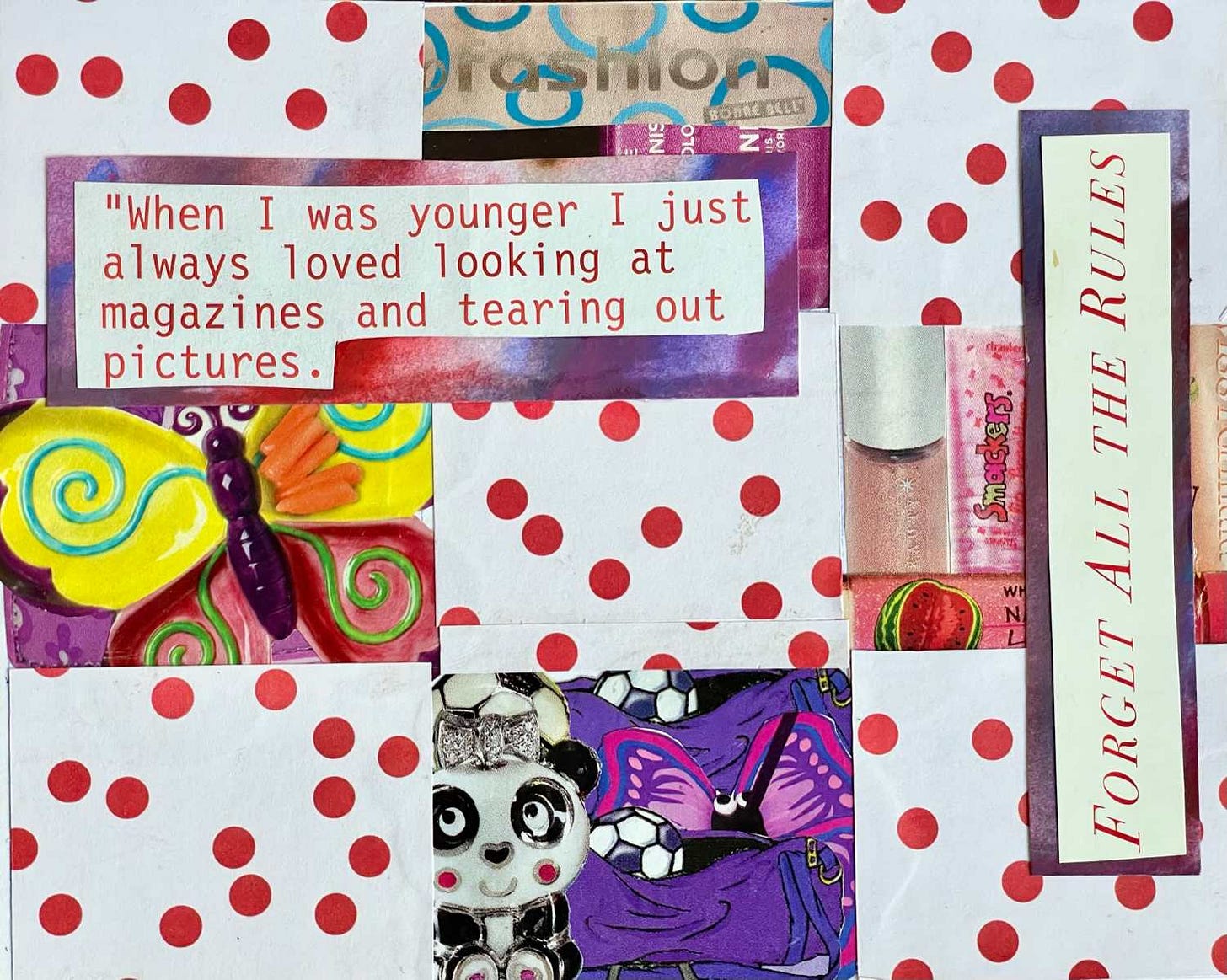How Collage Is Like Writing
Plotting vs. pantsing, three-part structure, taking steps back, and more
I recently discovered the work of Mike Bernard after reading his book Collage, Colour and Texture in Painting. I read it cover to cover, fascinated with his artwork and style, his work processes and philosophies. It struck me throughout that collaging—and other art forms—has a lot in common with writing.
I started collage during the pandemic, listening to music, audiobooks, or podcasts while gluing down images. And these weren’t just any images. I’ve rescued magazines from the recycling bin since my age was in the one-digits, cut out pictures of lipgloss, stuffed animals, and a bewildering number of platform sandals, and collected them in an old Altoids tin. My eye for images has since evolved from pre-teen obsessions, though I still find the occasional LipSmackers or lotion image lying in there.

Why? It’s compulsive, meditative, satisfying. It’s one of those hobbies that stayed just that—a pure hobby with no end goal or “point” besides the fact that I like it. It isn't a side hustle and I have no plans to monetize it—or whatever it is the Type A brain of mine thinks I should be doing.
I have a counterproductive habit of resisting art projects. I have so many ideas and inspirations, but when the time comes to sit down and do it, it’s like I have a fear of the blank canvas (not unlike the fear of the blank page). Until… one fine, monotonous pandemic day, I felt that old itch to make something, convey something—a feeling, a memory, a combination of both—but I didn’t want to write about it. I wanted to relax and lose focus. By that time I had folders, boxes, and tins of paper scraps, so I started gluing them down.
I’ve found that collaging is one of the most easy-going ways to feel creative.
How Collage Is Similar to Writing
Plot Structure = Artistic Composition
Mike Bernard writes:
“The composition—the choice of subject matter and the way that it is arranged within the picture area—is one of the most significant aspects of the painting process.”
Which sounds very much how you decide to structure your novel, including plot points, character, story arc, and setting. And while “intuition and personal preference play a part,” there is a correct way to structure a novel or painting, outside of whose bounds you become, well, not necessarily incorrect, but more experimental or avant-garde…but you can’t reach this point without first knowing what rules there are to break—i.e., the composition.
Plotting vs. Pantsing = Prepping the Canvas
It’s ye olde “plotter vs. pantser” dichotomy—which could stand to be accompanied with the disclaimer that people are normally based along a continuum, neither in one camp nor the other entirely.
Mike Bernard similarly notes:
“The amount of preparation and planning required before starting a painting is a matter for individual judgment. Some artists like to have the composition, colour scheme and similar key aspects of the painting well resolved before they make a start, while others prefer a more spontaneous approach.”
Writing What Happened vs. the Truth = Representation in Art
“…it is always important to bear in mind that while the subject matter should inspire you, it should never dictate how you work.”
Especially in historical fiction, sometimes you can get bogged down attempting to describe what happened as exactly as possible, which can get in the way of telling a truth that is not so literal, yet better represents the idea you want to express.
Taking a Pause = Stepping Away
I’ve previously written about the need to take a pause between editing sessions and full read-throughs in order to bring my mind out of the trees to see the forest. Likewise:
“When you are working on a painting, and therefore are totally involved with it, you become very aware of every mark and detail. However, after leaving it for a time, and then seeing it again, the first response is always the general sense of the painting, its coherence and overall impact, and this is what counts most.”
The Three-Act Structure = The Rule of Thirds
The tried-and-true structure of a novel, movie, and any successful story is the three-act structure: setup, conflict, resolution. The most important plot points happen at the meeting point of each section.
Likewise, the composition of a work of art, be it a painting or photography, has the best impact when working with the rule of thirds. If the picture is divided horizontally or vertically into thirds, wherein focal areas occur at the intersections of lines in this 9-square grid, then the arrangement of the picture will be more pleasing and impactful. And we all appreciate a more pleasing, impactful story or work of art.
Stuff I Like
Collage, Colour and Texture in Painting by Mike Bernard, for all the reasons listed above. Also, it’s the first book of its kind that I’ve read like a storybook. He has a lot of helpful pointers if you are looking to do any kind of mixed media including collage and paint.
UHU Gluestick: Since we’re talking collage, UHU is the best glue stick that actually works (drop the purple stuff. Now).



